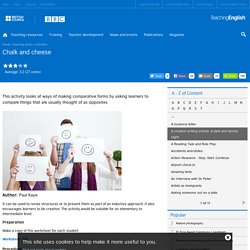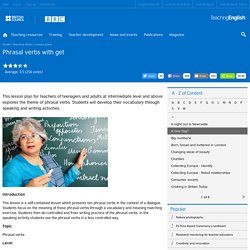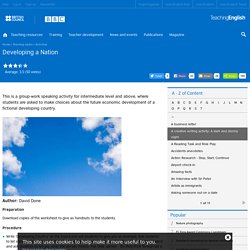

Chalk and cheese. This activity looks at ways of making comparative forms by asking learners to compare things that are usually thought of as opposites.

It can be used to revise structures or to present them as part of an inductive approach. It also encourages learners to be creative. The activity would be suitable for an elementary to intermediate level. Preparation Make a copy of this worksheet for each student Worksheet 54k Procedure Dictate the complete word pairs on the handout (pairs 1 – 5) to learners. This activity looks at ways of making comparative forms by asking learners to compare things that are usually thought of as opposites.
It can be used to revise structures or to present them as part of an inductive approach. Preparation Make a copy of this worksheet for each student Worksheet 54k Procedure Dictate the complete word pairs on the handout (pairs 1 – 5) to learners. Phrasal verbs with get. This lesson plan for teachers of teenagers and adults at intermediate level and above explores the theme of phrasal verbs.

Students will develop their vocabulary through speaking and writing activities. Introduction This lesson is a self-contained lesson which presents ten phrasal verbs in the context of a dialogue. Students focus on the meaning of those phrasal verbs through a vocabulary and meaning matching exercise. Students then do controlled and freer writing practice of the phrasal verbs. Topic. Developing a Nation. This is a group-work speaking activity for intermediate level and above, where students are asked to make choices about the future economic development of a fictional developing country.

Preparation Download copies of the worksheet to give as handouts to the students. Procedure Write ‘Developing Country' on the board and ask students to give you an example. Classroom issues. Learners have a lot of ideas about how they should learn a language and it is important to encourage them to discuss these and to communicate them to the teacher.

Many of these ideas are not necessarily things you agree with, and discussion also gives you an opportunity to explain your beliefs about language learning and share your rationale. The example cards can be used in a variety of ways depending on your need. Each one has an opinion that is often heard in classrooms. Example issue cards 47k Possible uses You can use them as discussion prompts, with learners in groups.
Note: You can guide discussion in all of these activities by selecting the cards you want learners to have. If you do find learners respond to these activities and really do start to give opinions, be ready to respond with the same honesty and make sure you know why you do things the way you do them! From the NonProfit Industrial Complex with Love » The Manufacturing of Greta Thunberg – for Consent: The Political Economy of the Non-Profit Industrial Complex [ACT I] January 17, 2019 “What’s infuriating about manipulations by the Non Profit Industrial Complex is that they harvest the goodwill of the people, especially young people.
![From the NonProfit Industrial Complex with Love » The Manufacturing of Greta Thunberg – for Consent: The Political Economy of the Non-Profit Industrial Complex [ACT I]](http://cdn.pearltrees.com/s/pic/th/industrial-manufacturing-202738908)
They target those who were not given the skills and knowledge to truly think for themselves by institutions which are designed to serve the ruling class. Capitalism operates systematically and structurally like a cage to raise domesticated animals. Those organizations and their projects which operate under false slogans of humanity in order to prop up the hierarchy of money and violence are fast becoming some of the most crucial elements of the invisible cage of corporatism, colonialism and militarism.” — Hiroyuki Hamada, artist 1958: “17-year-old Bianca Passarge of Hamburg dresses up as a cat, complete with furry tail, and dances on wine bottles.
The Manufacturing of Greta Thunberg – for Consent series has been written in two volumes. [Volume I: ACT I • ACT II • ACT III • ACT IV • ACT V • ACT VI • Addenda I] [Book form] 7 traits great pilots have in common. Describing people and prioritising characteristics. What makes a successful entrepreneur. U3 Learning from our mistakes.
Fishbone template. Learning from mistakes in aviation. Lifestyle U1 Requests & Networking. 7 Traits Great Pilots Have in Common - Hartzell Propeller. Becoming a pilot is about more than training and building flying skills.

Beyond the technical abilities required to earn their wings, pilots must also develop a balance of leadership skills, discipline, critical thinking skills, and a proper attitude. And while no two pilots are exactly the same, there are several qualities that are common among successful pilots. Here are a few examples of positive traits that great pilots share. Attention to detail When it comes to flying, small mistakes can make a big impact, and there’s little room for error in the skies. Situational awareness Situational awareness is a critical aspect of risk management that refers to a pilot’s mental picture of the aircraft’s physical position in space and its relation to the elements of flight and is a critical factor of risk management in flying.
Self-confidence Self-confidence is another common trait among great pilots. Humility The best pilots have confidence, but they also recognize the value of humility. How We Can Learn From Incidents. Learning from mistakes in aviation.